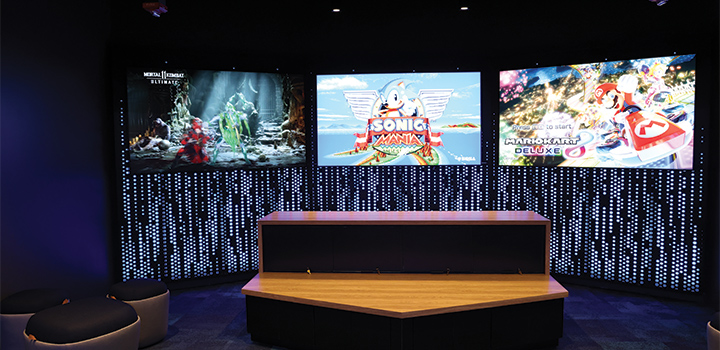As generations of students come and go, their needs and wants change. Club sports, intramurals and esports are all a part of this evolving landscape. For leaders of competitive sports programming, it’s hard to be on top of trends while remaining cognizant of students’ needs.
Kathryn Hutchings, the assistant director for Club Sports at Santa Clara University (SCU), detailed how leadership within the club sports scene on campus has changed in recent years. She noted their club sport student leaders need more direction. They thrive when plenty of resources are provided regarding issues of risk management, team leadership and management, managing finances, fundraising, and more.
Along with helping students improve their leadership skills, these resources ensure all club sports teams know of the university’s policies and regulations. “I highly recommend they have weekly or monthly leadership meetings with me so I can help keep them on track,” said Hutchings. “It seems most students today need more than a link with a ‘how to’ document. They prefer more one-on-one training to show actual examples in order to become successful in their roles.”
While student leadership support is one standout to Hutchings at SCU, many of the problems and concerns surrounding competitive sports operations have stayed the same. Hutchings noted no club sports program looks the same nor has the same needs or concerns. However, there are common trends.
EXTRA CREDIT: Creative competitive sport offerings.
“When it comes to club sports, everything varies as the resources available to support them are different for everyone,” explained Hutchings. “However, for SCU and likely many others, club sports are seeking more funding and more facility space on campus for practices and competitions.”
Identifying trends at other campuses can be helpful. Dylan Whisman, the Intramural Sports coordinator at the University of Cincinnati (UC), emphasized the usefulness of being a part of a professional network. He recommended NIRSA and their Connect platform. Analyzing trends other professionals are seeing in their competitive sports programming helps him notice similar transformations in his students.
One change Whisman has seen is a heavier emphasis on mental well-being. Along with the physical exercise and enrichment that intramural sports provide, mental health has become more important to students and — in effect — the staff.
“As we establish a stronger connection between mental and physical health, the significance of campus recreation increases,” said Whisman. “Students need a consistent avenue for a well-being reset more than ever before. Intramurals has stepped forward as a spearhead for this rising demand by promoting well-being in a convenient manner.”
For example, students asked for a more consistent array of activities. The rec staff listened and implemented their feedback by offering summer intramurals along with normal semester offerings. Unique and overall participation has increased since then.
EXTRA CREDIT: Pickleball is trending — here’s what you need to know to bring it to campus.
Whisman expressed how the UC rec staff are constantly looking for areas of improvement when it comes to competitive sports offerings. “We’ve taken a specific focus on continued benchmarking — collecting data on how other programs are operating, and seeing how we can take their successful foundation to build an improved program here,” said Whisman. “As we move forward, we must recognize, appreciate and uplift the significant role that physical activity has on the well-being of the student. I firmly believe in the integration of mental and physical health, and the science coming out only confirms the adaptation necessary for campus recreation departments.”
Compared to club sports and intramurals, esports are newer to campuses across the U.S. According to the Next College Student Athlete, the largest collegiate athletic recruiting platform, 175 colleges and universities offer esports as a varsity sport. Creating a recreation program is a logical next step for many of them.
Penn State’s esports program has grown exponentially since it started in 2011. Its latest addition is the 3,000-square-foot Esports Center which opened at the start of the 2023-2024 school year. Steve Kampf, the senior director of Campus Recreation, explained the importance of a dedicated space for students.
“The esports center provides a space to meet others with a common interest,” explained Kampf. “A majority of past esports participation has been conducted in the students’ own space. The new facility provides an outlet to meet others with a common interest.”
EXTRA CREDIT: An in-depth look at the esports landscape.
That population is growing. Kampf noted various leagues and game-specific competitions have seen a lot of development. H predicts it will only continue to increase on campus.
Along with the new facility, Kampf said they try to keep up with the games and gaming systems students are requesting or may be interested in checking out. The facility is meant to be a resource for all students. This includes those in competitive leagues and those who simply enjoy video games.
“Embrace the idea of including esports into campus recreation,” encouraged Kampf. “It provides an opportunity to reach students who might not participate in a traditional program. Penn State recreation is focused on providing inclusivity for all students. We are seeing the social benefits of providing a common space for students with similar interests to meet, congregate and play.”
No matter the program, meeting students’ needs should be the motive for any decision. The field of competitive sports is constantly evolving, but the right knowledge and attitude is always the foundation of success.










